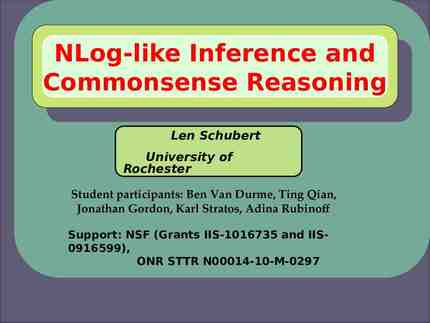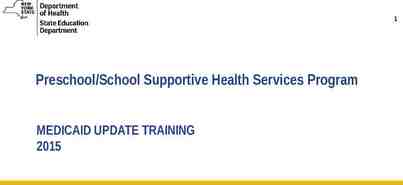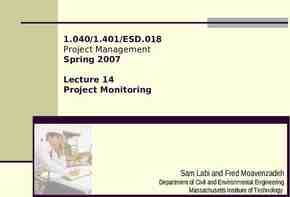EMA ORIENTATION SEMINAR MODULE 4 PLANNING, WEBEOC, & LEPC {{
46 Slides3.98 MB
EMA ORIENTATION SEMINAR MODULE 4 PLANNING, WEBEOC, & LEPC {{ October 2021
MODULE 4 In this module we will go over: Planning Presented by: WebEOC Presented by: LEPC Presented by:
{{ SECTION PLANNING DIVIDER In this portion Optional “presenter” description will godown over here, planning etc. initiatives.
PLANNING SECTION ORG CHART Peri Rogowski State Planning Officer Janice Lee Division Project Manager Allison Curry Natural Hazards Planning Manager Selena Rosas Critical Infrastructure & Logistics Planning Manager Vacant Emergency Services Planning Manager Scott Huffman Continuity Planning Manager Joshua Kiilu Cybersecurity & Risk Assessment Felicia Wolfe Technological Hazards Planning Manager Vacant Mass Care Planning Manager
PLANNING SECTION RESPONSIBILITIES Manage statewide Emergency Management and Homeland Security planning and assessment initiatives Develop and maintain over 50 state-level emergency plans including the State Emergency Operations Plan (EOP), associated annexes, support and hazard specific plans and continuity plans using the FEMA 6-Step Planning Process, Community Lifelines and Whole Community planning methodology Develop county planning templates, provide local EMAs guidance, review and feedback of county emergency plans and risk assessments Oversee state compliance of the federally mandated National Incident Management System (NIMS) which includes all 6 components: National Qualification System Incident Command System (ICS) Resource Typing Mutual Aid Emergency Operations Centers Inventorying Provide leadership and staffing for the State EOC Planning Section and ESF-14 during activations Provide leadership and staffing support for the Indiana Incident Management Assistance Team (IMAT)
SECTION RESPONSIBILITIES CONTINUED Oversees the National Risk Assessment (NRA) compliance requirements for the state. Includes development, coordination, analysis, and reporting of the following national risk assessments: State Hazard Identification and Risk Assessment (HIRA) State Threat and Hazard Identification and Risk Assessment (THIRA) State Stakeholder Preparedness Review (SPR) Special Event Assessment Rating (SEAR) Report National Incident Management System (NIMS) Compliance Report Comprehensive Preparedness Guide (CPG) 101 Compliance Report
SECTION RESPONSIBILITIES CONTINUED Collaborate and provide support to the IDHS Exercise Section during exercises which validate plans and assist in the development of the Integrated Preparedness Plan (IPP) Collaborate and provide training data to the IDHS Training Section collected from SPR for RTIPP Oversee compliance of the national Emergency Management Accreditation Program (EMAP) Conduct After Action Reports (AARs) and improvement plans (IPs) for real-world incidents
SECTION RESPONSIBILITIES CONTINUED Oversee the new ESF-14 (Cross-Sector Business and Infrastructure) Creating a Business Emergency Operations Center (BEOC) Working to build a Private-Public Partnership to support ESF-14
SECTION RESPONSIBILITIES CONTINUED Work with federal, state and local partner agencies on a variety of hazard-specific and support plans, training, and exercise projects including: Continuity of Operations and Continuity of Government Planning Complex Coordinated Terrorist Attack Full-Scale Exercise (with Kentucky) Cybersecurity Natural hazards including earthquake, tornado, flood, winter and summer weather events Logistics and Critical Infrastructure Security Planning CBRNE (Chemical, Biological, Radiological, Nuclear and Explosive) Planning Terrorism Consequence and Active Shooter Planning Mass Care, Emergency and Disaster Medical and Healthcare Planning Election Security Planning Civil Unrest Planning Emergency Communications and Notifications
HIRA / THIRA / SPR / SEAR / NIMS / CPG 101 REPORT CYCLES HIRA Reports Due Every 3 Years by 1/30 THIRA Reports Due Every 3 Years by 11/15 SEAR Report Due Every Year by 8/31 CPG 101 Reports Due Every Year by 11/30 SPR Reports Due Every Year by 11/15 NIMS Report Due Every Year by 11/30 HIRA – Foundation for THIRA Step 1 - Conducted Every 3 Years: Due January 30th of 2021 – 2024 – 2027 THIRA – Foundation for SPR Step 1 - Conducted Every 3 Years: Due November 15th of 2022 – 2025 – 2028 SPR – Measures Progress of Core Capability Gaps - Conducted Every Year: Due November 15th SEAR – Measures Risk of a Terrorist Attack at a Special Event - Conducted Every Year: Due August 31st NIMS – Annual Compliance Report Required by FEMA - Conducted Every Year: Due November 15th CPG 101 – Tracks Annual Planning Development - Conducted Every Year: Due November 15th
HAZARD IDENTIFICATION AND RISK ASSESSMENT (HIRA) The HIRA is a quantitative process in which counties select all natural, man-made or technological hazards or threats that present the greatest risk to their community. The HIRA uses a Calculated Probability Risk Index (CPRI) formula that measures the probability, magnitude/severity, warning time, and duration of the known hazard or threat. It allows state and local government officials to better assess their risks to plan and prepare for consequences of threats and hazards. The HIRA results generate the information needed for the THIRA, Step 1.
THREAT & HAZARD IDENTIFICATION RISK ASSESSMENT (THIRA) THIRA is a 3-step risk assessment completed every 3 years. The THIRA helps communities understand their risks and determine the level of capability they need in order to address those risks. The outputs that form this process lay the foundation for determining a community's capability gaps as part of the Stakeholder Preparedness Review. The THIRA includes standardized language to describe threat and hazard impacts and capability targets. This allows communities to collect more specific, quantitative information while also providing important context.
STAKEHOLDER PREPAREDNESS REVIEW (SPR) The SPR is a 3-step process completed annually and measures the progress of the capability targets identified in the current THIRA Communities collect detailed and actionable data on current capabilities and identified gaps and identify priorities and timelines Communities indicate their approaches for reducing gaps and assess the impact of relevant funding on building and sustaining capabilities County EMAs gather feedback from county stakeholders, SMEs, businesses, non-profit organizations, and higher education partners SPR results assist the state and federal government in prioritizing capabilities to build and sustain, plan for threats and hazards, and validate capabilities used in mitigation plans and grant justifications
SPECIAL EVENT ASSESSMENT RATING (SEAR) Measures the threat, vulnerability and consequences of special events. Includes sporting and conference events, concerts, festivals, fairs, parades, and other local group gatherings. All data is input into WebEOC. All SEAR events are submitted to the US Department of Homeland Security’s Office of Operations Coordination who applies a risk-based methodology to all submitted events and assigns them a SEAR rating as described below:
NIMS COMPLIANCE SURVEYS The annual National Incident Management System (NIMS) survey is directed by the Homeland Security Presidential Directive (HSPD)-5 which requires adoption of NIMS by state, tribal, territorial and local organizations as a condition for federal preparedness assistance through grants, contracts and other activities. IDHS has created an on-line NIMS compliance survey to create a more streamlined experience for emergency managers. This on-line survey is due annually no later than November 15 th.
CPG 101 PLANNING COMPLIANCE SURVEY The annual Comprehensive Preparedness Guide (CPG) 101 compliance survey supplements CPG-101 by tracking the timing for developing or revising emergency operation plans and captures planning elements contained in CPG-101 The CPG 101 survey is combined with the NIMS survey and Comprehensive Preparedness Guide (CPG) 101 planning survey to create a more streamlined experience for emergency managers. This on-line survey is due annually no later than November 15 th.
COMPILATION OF NPS CROSSWALK VIEW-AT-A-GLANCE
DISTRICT PLANNING MANAGER SUPPORT District 1 – Joshua Kiilu – [email protected] District 2 – Felicia Wolfe – [email protected] District 3 – Peri Rogowski – [email protected] District 4 – Felicia Wolfe – [email protected] District 5 – Janice Lee – [email protected] District 6 – Janice Lee – [email protected] District 7 – Scott Huffman – [email protected] District 8 – Scott Huffman – [email protected] District 9 – Selena Rosas – [email protected] District 10 – Allison Curry – [email protected]
PLANNING AND ASSESSMENT GUIDANCE National Planning Frameworks National Incident Management System (NIMS) Comprehensive Preparedness Guide (CPG) 101 (Planning) and CPG 201 (THIRA/SPR) Securing Public Gatherings Presidential Policy Directive / PPD-8: National Preparedness National Preparedness Goal Whole Community Key Components of Presidential Policy Directive 8 and Estimating Capability Requirements National Risk and Capability Assessment (THIRA/SPR) Community Lifelines Critical Infrastructure Sectors Continuity Programs
[email protected] {{2921 {{ INDIANA DEPARTMENT OF HOMELAND SECURITY 302 West Washington Street Room E208 Indianapolis, IN 46204
THANK YOU!
{{ SECTION WEBEOC DIVIDER In this Optional portion “presenter” descriptionwill down go over here,aetc. WebEOC orientation tutorial.
OBJECTIVES Home Page County Home Dashboard Events Board
WEBEOC HOMEPAGE
COUNTY DASHBOARD
COUNTY STATUS
WEBEOC MONTHLY TEST Incident to use 2021 WebEOC Monthly Test Exercise Required Action EOC Activation Change Suggestive Action EOC Activation Change Travel Advisory Change Opportunity to remain proficient
WEBEOC POST What - A brief synopsis, including: – Threat – The nature of the problem – Vulnerability – Why this is a problem – Consequences – The potential impact of the incident Where - location of the report, information should be as specific as possible When – the time and date of the report Who - the name of the person making the report, and the agency he or she works for
EVENT TYPES Agriculture and Animal Communications Earthquake Emergency Management Energy External Affairs Fire Flooding Law Enforcement Logistics Long Term Recovery Mass Care Oil and Hazardous Materials Public Health Public Works Search and Rescue Test Transportation Weather
TYPES OF INCIDENTS All Hazards – Potential to expand beyond capability of daily operations – Crosses multiple jurisdictions Severe weather Incidents involving interstate closures Working HazMat incident Large fires involving more than one department Unknown substance calls – Schools, Government Facilities, etc. Bomb or EOD activity Active shooter incidents
TYPES OF INCIDENT CONT. Serious injury or death of public safety personnel Dam or levee problems/issues Industrial accidents Explosions of any kind Hazardous radiation incident Search and rescue operations – Amber/Silver Alerts Structural collapses Train derailments
EVENTS/INCIDENTS BOARD Information can be kept at the district level without involving the state IDHS does not actively monitor district E/I boards – Will see if pushed to State board – Will see if pushed to other jurisdictions Main source of incident information Scrolling feed of incident information Variety of users may contribute with posts Posts may be updated Incident dependent Search Capability
EVENTS/INCIDENT DISPLAY
EVENTS/INCIDENTS INPUT
EVENT MAPPING
MISSIONS AND TASKS What is the mission? There may not be a specific resource you request so being specific with the mission allows logistics to come up with other resources that can meet the goal of the mission.
WEBEOC USER GUIDE Please take this time to fill out the WebEOC User Guide and turn it into your Liaison. They will then get your account created.
THANK YOU!
{{ SECTION LEPC DIVIDER In this portion Optional “presenter” description will go down overhere, LEPCetc. information.
SUPERFUND AMENDMENTS AND REAUTHORIZATION ACT (SARA) Title III of SARA is known as the Emergency Planning and Community Right-to-Know Act (EPCRA). Identify the storage, use, and release of chemicals. Foster communication between facilities that handle hazardous chemicals and their communities. Expand emergency planning for hazardous chemical accidents and enhance emergency response capabilities for hazardous chemical incidents. Under Section 312 of EPCRA, facilities are required to submit a Tier II form to state, local officials, and the public on potential hazards. The information includes the locations and amounts of hazardous chemicals present at a facility during the previous calendar year.
INDIANA EMERGENCY RESPONSE COMMISSION (IERC) Meets bimonthly on the second Monday at 1:30pm EST starting in January. A virtual option for attendance will always be available. The meeting information can be found https://www.in.gov/dhs/boards-and-commissions/indiana-emergency-re sponse-commission/ The IERC was established to implement the Emergency Planning and Community Right-to-Know act of 1986 (EPCRA).
LOCAL EMERGENCY PLANNING COMMITTEE (LEPC) LEPCs develop and maintain an emergency response plan to deal with accidental chemical releases from facilities in their respective county. LEPCs also provide information, upon request, about chemicals in the community to the general public. An LEPC can also direct the public records request to IDHS https://www.in.gov/dhs/public-records-request-web-form/ Compliant LEPCs receive funds from Tier II Facility fees once a year. This money can be spent on training, hazmat equipment, etc. See IC 6-6-10-7(b) for a complete list of LEPC spending categories.
LEPC COMPLIANCE The LEPC has several activities to complete throughout the year to be compliant and receive funding. January 31st – Legal Notice March 1st – Bylaws March 1st – Roster March 1st – Fiscal/Auditors Report (prior year) May 1st – Exercise Proposal Report The final exercise report needs uploaded 60 days after the exercise. The exercise is not required to be HSEEP complaint unless using grant funding. October 16th – Hazardous Materials Response Plan Completion and upload of at least four meetings and meeting minutes Two meeting in the first half of the year and two meetings in the second half. Contact the LEPC/IERC program manager for Tier II Manager access, if needed.
CONTACTS IERC/LEPC Program Manager Amanda Horner [email protected] Cell: (317) 954-4388 Office: (317) 234-9696 SARA Tittle III Program Manager Casey Kenworthy [email protected] Cell: (317) 671-0981 Office: (317) 234-9697
THANK YOU!
END {{



















































